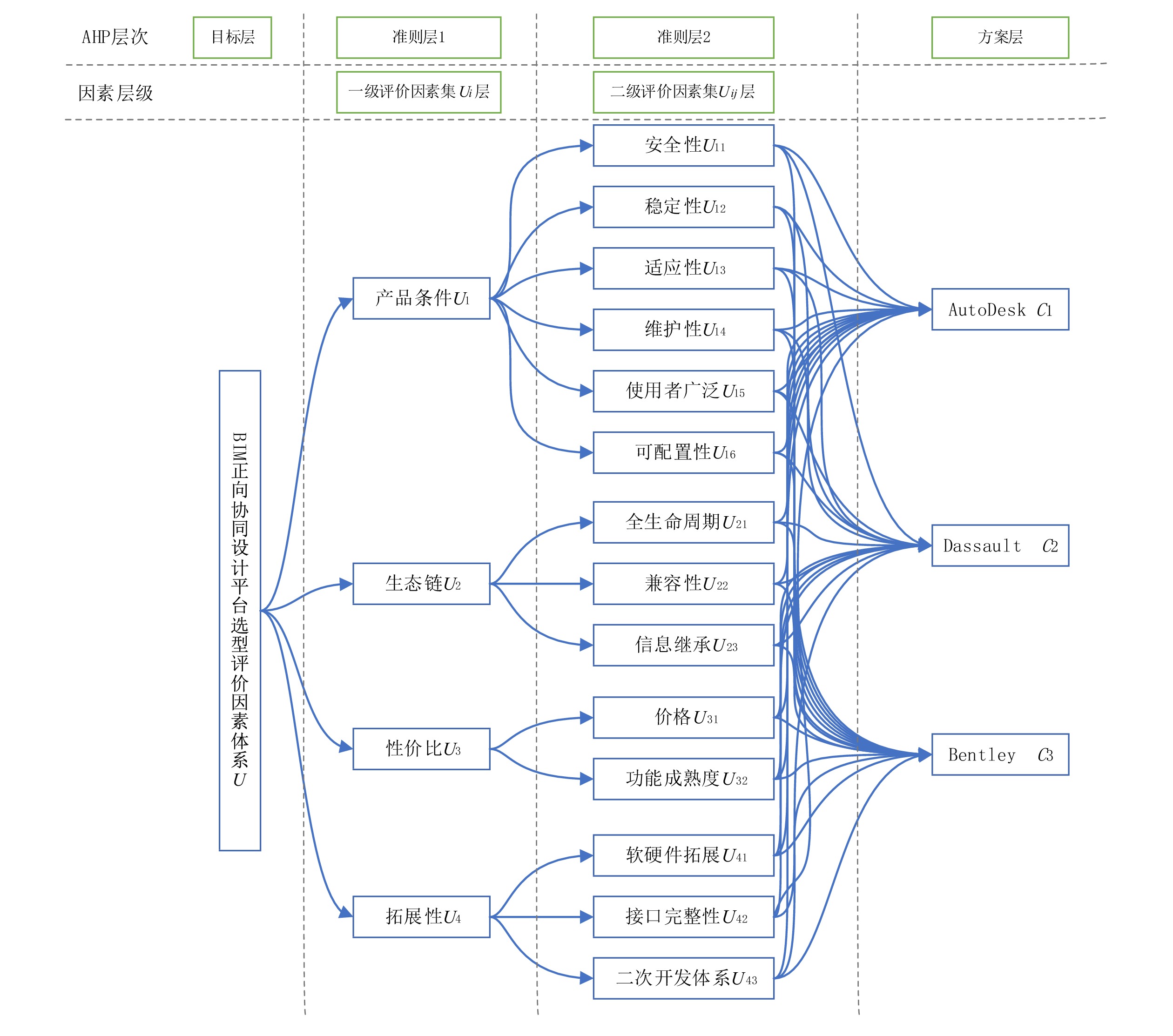Type selection analysis of BIM forward collaborative design platform based on Fuzzy Analytic Hierarchy Process
-
摘要: 针对BIM软件平台产品多且产品条件、生态链、性价比、拓展性等差异性大而导致的选型评价共性问题,构建了基于模糊层次分析法的BIM正向协同设计平台选型评价模型。该模型具有相对准确、客观的选型评价能力,具有将定性指标转为定量指标、降低主观因素影响的特点。实践表明,该模型能够实现对主流AutoDesk、Dassault、Bentley等平台的选型评价目标,具有为多层级因素综合评估类工作提供切实可行的通用参考模型的价值。Abstract: In view of the common problems in the type selection and evaluation of Building Information Modeling(BIM) software and platform due to the large differences in product conditions, ecological chain, cost performance, and expansibility, this paper constructed the type selection and evaluation model of BIM forward collaborative design platform based on Fuzzy Analytic Hierarchy Process, which had relatively accurate and objective type selection and evaluation ability, and had the characteristics of transforming qualitative indicators into quantitative indicators and reducing the influence of subjective factors. Practice shows that the model can achieve the type selection and evaluation objectives of mainstream AutoDesk, Dassault, Bentley and other platforms, and has the value of providing a feasible general reference model for multi-level factor comprehensive evaluation.
-
BIM正向协同设计平台是具有日常设计生产、专业内及多专业间协同、多地协同、多层级审核、成果输出所需图纸报表、数字化移交、工程建设全生命周期数据通用等功能的综合性平台。该平台与翻模模式中单一软件应用模式完全不同,能提供成体系的设计技术转型升级解决方案。在当前数字中国、数字经济的建设背景下,基于市场竞争、产业升级、自身发展等需求,数字化转型已是勘察设计企业必然选择,核心业务工程设计的转型升级则是重中之重,而BIM正向协同设计平台选型则是决定数字化转型升级成败的关键。
本文结合勘察设计企业的特点,研究并分析了BIM正向协同设计平台选型的影响因素,建立了一套包含4个方面共计14个因素的评价因素集,构建了一套科学合理、普遍适用的选型评价模型,研究结果能够使勘察设计企业在数字化转型中少走弯路,节约时间成本、人力成本及资金成本。
1 研究模型
BIM正向协同设计平台选型评价存在主观因素影响、评价因素权重不明确、衡量单位不一致等问题,难以进行统一量化。比较层次分析法(AHP,Analytic Hierarchy Process)、模糊综合评价法(FCEM,Fuzzy Comprehension Evaluation Method)、秩和比法、综合指数法、TOPSIS(Technique for Order Preference by Similarity to an Ideal Solution)法等综合评价法的适用范围、优缺点后发现,AHP[1]是定性与定量结合的多层次多目标决策综合分析的方法,FCEM[2]是模糊数学中隶属度理论把定性指标转化为定量指标的方法,这两者结合应用,形成模糊层次分析法(FAHP,Fuzzy Analytic Hierarchy Process)[3],能将不完全信息、不确定信息、主观信息转化为评价等级数字,做到定性问题定量化,从而使选型定性评估工作转换为数学定量工作。本文基于FAHP进行BIM正向协同设计平台选型分析。
1.1 AHP
AHP通过建立选型数学模型,结合九级标度法、专家调查法等,实现定性指标转换为定量指标综合分析。本文采用软件yaahp建立层次模型、MATLAB辅助求解与复核,得出准确、可信的评价因素权重[4]。
1.1.1 九级标度法
九级标度法对同层次评价因素进行两两对比并量化,依次标出各个评价因素的相对重要程度。九级标度法的标度及其定义如表1所示,其中,ai、aj为同层次评价因素;aij为ai与aj的重要性比较,aji为aj与ai的重要性比较;i,j=1,2,···,n,n为当前层次存在的评价因素数量。例如,ai 比 aj 略微重要,根据表1可得,aij=3,aji=1/3。
表 1 九级标度法的标度及其含义标度aij 含义 1 ai与aj同样重要 3 ai比aj略微重要 5 ai比aj重要一些 7 ai比aj重要得多 9 ai比aj绝对重要 2,4,6,8 处于1,3,5,7,9的中间状态 倒数 aj与ai比较,aji=$\dfrac{1}{ {a}_{ij} }$
;评价因素与自身比较,aij=aji=11.1.2 一致性检验
在专家调查法中,因专家之间存在工作性质、专业背景、认知等方面的偏差,专家自身对不同评价因素的理解不同,对评价因素之间重要性程度的认识存在逻辑错误的可能性,如甲比乙重要、乙比丙重要、丙比甲重要。为避免出现这一问题,本文引入一致性检验。
设当前层次存在n个评价因素,其评价因素成对比较矩阵为A,如式(1)所示。
$$ {\boldsymbol{A}} = \left[ {\begin{array}{*{20}{c}} {{a_{11}}}&{{a_{12}}}&{\begin{array}{*{20}{c}} \ldots &{{a_{1n}}} \end{array}}\\ {\begin{array}{*{20}{c}} {{a_{21}}}\\ \vdots \\ {{a_{n1}}} \end{array}}&{\begin{array}{*{20}{c}} {{a_{22}}}\\ \vdots \\ {{a_{n2}}} \end{array}}&{\begin{array}{*{20}{c}} {\begin{array}{*{20}{c}} \ldots &{{a_{2n}}} \end{array}}\\ {\begin{array}{*{20}{c}} & \vdots \end{array}}\\ {\begin{array}{*{20}{c}} \ldots &{{a_{nn}}} \end{array}} \end{array}} \end{array}} \right] $$ (1) 设成对比较矩阵A的特征根为λ,最大特征根为λmax。特征根λ通过MATLAB的函数eig和函数diag求得,如式(2)所示。
$$ \left\{\begin{array}{l}{{\boldsymbol{A}}}=[{a}_{11},\cdots ,{a}_{1n};{a}_{21},\cdots ,{a}_{2n};\cdots ;{a}_{n1},\cdots ,{a}_{nn}]\\ \left[{{\boldsymbol{v}}},{{\boldsymbol{d}}}\right]=\mathrm{e}\mathrm{i}\mathrm{g}\left({{\boldsymbol{A}}}\right)\\ \lambda =\mathrm{d}\mathrm{i}\mathrm{a}\mathrm{g}\left({{\boldsymbol{d}}}\right)\\ {\lambda }_{{\rm{max}}}=\mathrm{m}\mathrm{a}\mathrm{x}\left(\lambda \right)\end{array}\right. $$ (2) 其中,v表示各列相应特征向量矩阵;d表示特征根组成的对角矩阵;函数eig求解v,d;函数diag提取对角线元素组成的向量。
根据Perro-Frobineus定理,设成对比较矩阵A的一致性指标为CI,其中,CI=0表示完全一致,CI越接近0表示一致性越高,CI越大表示不一致性越高。为了衡量CI,本文引入萨蒂(T.L.Saaty)提出的随机一致性指标RI,随机构造1 000个成对比较矩阵C1−C1000,计算一致性指标(CI1-CI1000),RI为(CI1-CI1 000)的算术平均值。本文还定义一致性比例CR。相关RI与f对应数值,及CI、CR计算如式(3)所示。
$$ \left\{\begin{array}{l} CI=\dfrac{{\lambda }_{max}-f}{f-1}\\ f \; \;\; \; \; \; \; \; \; \; \; \;1 \; \; \; \; \; \; \;2 \; \; \; \; \; \; \;3 \; \; \; \; \; \; \; \; 4 \;\; \; \; \; \; \; \;5 \; \; \; \; \; \; \; \; 6 \; \;\cdots \; \; 14 \; \; \; \; \; \;15\\ RI=(0.00\;\;0.00\;\;0.52\;\; 0.89\;\; 1.12 \;\;1.26 \cdots 1.58\;\; 1.59)\\ CR=\dfrac{CI}{RI}\end{array}\right. $$ (3) 其中,f为成对比较矩阵A的阶数;当CR<0.1时,表示成对比较矩阵A满足一致性检验;反之,则表示成对比较矩阵A需要进行修正。
1.1.3 评价因素权重
成对比较矩阵A以列为单位进行归一化处理,分别对各列元素进行求和。本文以列k为例,介绍归一化处理的过程。设行i列k元素的权重为ωik,其计算方式如式(4)所示。按此方式,对成对比较矩阵A逐列进行计算,得到归一化权重,并以行为单位,计算算术平均值,得到行权重ωi。
$$ \left\{\begin{array}{l}{\mathrm{\omega }}_{ik}=\frac{{a}_{ik}}{\displaystyle\sum _{j=1}^{n}{a}_{ij}}\\ {\mathrm{\omega }}_{i}=\dfrac{1}{n}\displaystyle\sum _{k=1}^{n}{\mathrm{\omega }}_{ik} \end{array}\right. $$ (4) 其中,n为当前层次评价因素的数量;i,j,k=1,2,···,n。
1.2 模糊综合评价法
1.2.1 确定评价集
多层级评价因素的模糊判断存在评价度量不一致的问题,为了解决该问题,本文构建了数学模型,建立了统一的评价集V=(vp)=(v1, v2, v3, v4, v5)=(优秀,良好,一般,合格,不合格),以确定评价因素的评价等级范围。评语集等级描述如表2所示。
表 2 评价集等级描述符号 等级 分值范围 分值基准 描述 v1 优秀 [90,100] 95 评价因素符合度为优秀,完全满足需求 v2 良好 [80,90) 85 评价因素符合度为良好,仍有提升空间 v3 一般 [70,80) 75 评价因素符合度为一般,存在部分问题 v4 合格 [60,70) 65 评价因素符合度为合格,存在缺陷亟待解决 v5 不合格 [0,60) 55 评价因素符合度为不合格,存在严重缺陷且暂时无法解决 1.2.2 建立模糊综合评价矩阵
设专家人数为N;给单评价因素 aij 打分为 vp 的人数为M;隶属度
$ {r}_{ijp}=\dfrac{M}{N} $ ,满足条件$\displaystyle\sum _{p=1}^{5}{r}_{ijp}=1$ ;单评价因素 aij 的模糊评价集为 V 的模糊子集Rijp=(rij1,rij2,rij3,rij4,rij5),建立方案层C,如图1所示,第q个方案的评价因素隶属度模糊关系矩阵RCq[5]。$$ {{\boldsymbol{R}}_{{C_q}}} = \left[ {\begin{array}{*{20}{c}} {{r_{111}}}&{{r_{112}}}&{\begin{array}{*{20}{c}} \ldots &{{r_{115}}} \end{array}}\\ {\begin{array}{*{20}{c}} {{r_{121}}}\\ \vdots \\ {{r_{{\rm{ij}}1}}} \end{array}}&{\begin{array}{*{20}{c}} {{r_{122}}}\\ \vdots \\ {{r_{{\rm{ij}}2}}} \end{array}}&{\begin{array}{*{20}{c}} {\begin{array}{*{20}{c}} \ldots &{{r_{125}}} \end{array}}\\ {\begin{array}{*{20}{c}} & \vdots \end{array}}\\ {\begin{array}{*{20}{c}} \ldots &{{r_{{\rm{ij}}5}}} \end{array}} \end{array}} \end{array}} \right] $$ (5) 其中,ij对应当前层次评价因素编号;q为方案层解决方案数量。
2 研究实验
为了对主流产品进行测试应用、价格摸底,本文对典型单位(如中国铁路设计集团、中电建华东勘测设计研究院)进行调研,邀请行业内的专家对关键因素的权重进行打分,并综合测试、商调、技术调研、专家调查等多种方法,得出产品选型以产品条件、生态链、性价比和拓展性四要素评价为主的结论。本文基于层次分析法建立判断矩阵,采用九级标度法调查数据,计算两级评价因素权重;基于FCEM计算评分隶属度;根据权重、隶属度、分值基准等构建的矩阵,整合计算各解决方案得分,并以此作为选型依据。
2.1 主流产品调查结果
BIM软件厂商有很多。国内的有广联达科技股份有限公司(简称:广联达)、鲁班软件股份有限公司(简称:鲁班软件)、北京构力科技有限公司(简称:构力)、广州中望龙腾软件股份有限公司(简称:中望软件)、北京探索者软件股份有限公司(简称:探索者软件)等。国外的有AutoDesk、Dassault、Bentley、Graphisoft、Trimble、Tekla等[6]。
国内工业软件,特别是BIM设计基础软件尚处于起步阶段。广联达布局BIM全生命周期应用,已发布广联达建筑设计工具软件、结构设计工具软件、机电设计工具软件、协同设计平台、设计资源平台等测试版,计划逐步取代国外产品。中望软件自主开发的国产三维设计软件,已应用于机械设计行业,并计划于2022年推出三维BIM平台核心,逐步向工程行业拓展。而国外工业软件起步早,已发展到一定阶段,目前,初步具备BIM正向协同设计能力的平台体系厂商主要为AutoDesk、Dassault[7]、Bentley[8]等,它们正向协同设计体系如表3所示。本文以这三者为例,进行BIM正向协同设计平台选型分析。
表 3 BIM正向协同设计体系序号 厂商 正向设计软件 应用扩展 协同方式 1 AutoDesk Revit
Civil3D
InventorNavisworks 跨域:Vault、RevitServer
内部:工作集、链接2 Dassault Catia
Solidworks
Geovia有限元分析:Simulia
施工仿真:Delmia
产品文档:3DVia
虚拟现实(VR,Virtual Reality)输出:3DExcite门户平台:3DExperience
设计管理:Enovia3 Bentley Microstaiton AECOsim ProjectWise 2.2 确定评价因素集
本文基于企业数字化转型升级需求,依据AHP构建与定义目标层为U、准则层1为一级评价因素集Ui 、准则层2为对应二级评价因素集Uij 、方案层为 Cq 等,其中,i为一级评价因素数量;j 为对应二级评价因素数量;q为解决方案数量。BIM正向协同设计平台选型评价因素集为U=(Ui)=(U1; U2;U3; U4)=(产品条件,生态链,性价比,拓展性)=(U1j; U2j; U3j; U4j)=(安全性,稳定性,适应性,维护性,使用者广泛,可配置性;全生命周期,兼容性,信息继承;价格,功能成熟度;软硬件拓展,接口完整性,二次开发体系)。评价因素体系与AHP分层,如图1所示。
2.3 计算评价因素权重
本文采用专家调查法,由20位业内研究人员组成专家组,运用九级标度法,由专家组成员对评价因素打分,并计算各评价因素的算术平均值,按四舍五入原则取整后作为评分结果,形成对应的评价因素成对比较矩阵A,并代入式(1)~式(4),在满足一致性检验要求的基础上[9],计算评价因素权重ω。一级评价因素Ui对应目标层U的权重ωi如表4所示,二级评价因素Uij对应一级评价因素Ui的权重ωij如表5~表8所示。
表 4 一级评价因素Ui对应目标层U的成对比较矩阵AU U1 U2 U3 U4 权重ωi U1 1 6 1 7 0.433 0 U2 1/6 1 1/5 2 0.087 3 U3 1 5 1 8 0.426 9 U4 1/7 1/2 1/8 1 0.052 8 λ 4.024 6 −0.016 0
+ 0.314 5i−0.016 0
−0.314 5i0.007 5 — λmax=4.024 6,f=4,CI=0.008 2,RI=0.89,CR=0.009 2<0.1,满足一致性检验要求。 表 5 二级评价因素U1j对应产品条件U1的成对比较矩阵A1U1 U11 U12 U13 U14 U15 U16 权重ω1j U11 1 3 4 4 7 9 0.398 6 U12 1/3 1 4 6 8 9 0.303 7 U13 1/4 1/4 1 3 4 6 0.140 1 U14 1/4 1/6 1/3 1 2 3 0.073 0 U15 1/7 1/8 1/4 1/2 1 5 0.058 5 U16 1/9 1/9 1/6 1/3 1/5 1 0.026 0 λ 6.551 4 0.084 6
+1.743 1i0.084 6
−1.743 1i−0.224 3
+0.718 5i−0.224 3
−0.718 5i−0.271 9 — λmax=6.551 4,f=6,CI=0.1103,RI=1.26,CR=0.087 5<0.1,满足一致性检验要求。 表 6 二级评价因素U2j对应生态链U2成对比较矩阵A2U2 U21 U22 U23 权重ω2j U21 1 3 4 0.623 2 U22 1/3 1 2 0.239 5 U23 1/4 1/2 1 0.137 3 λ 3.018 3 −0.009 1
+0.234 8i−0.009 1
−0.234 8i— λmax=3.018 3,f=3,CI=0.009 2,RI=0.52,CR=0.017 6<0.1,满足一致性检验要求。 表 7 二级评价因素U3j对应性价比U3成对比较矩阵A3U3 U31 U32 权重ω3j U31 1 1 0.5 U32 1 1 0.5 λ 0 2 — λmax=2,f=2,CI=0,RI=0,CR=0<0.1,完全一致。 表 8 二级评价因素U4j对应拓展性U4成对比较矩阵A4U4 U41 U42 U43 权重ω4j U41 1 2 4 0.5571 U42 1/2 1 3 0.3202 U43 1/4 1/3 1 0.1226 λ 3.0037 −0.0018
+0.1053i−0.0018
−0.1053i— λmax=3.0037,f=3,CI=0.0019,RI=0.52,CR=0.0036<0.1,满足一致性检验要求。 将二级评价因素权重ωij以一级评价因素权重ωi为基础计算其在目标评价因素中的权重ω=ωiωij,按照权重对二级评价因素排序,如表9所示。
表 9 层次总排序表U $ \dfrac{{U}_{1}}{0.433\mathrm{ }0} $ $ \dfrac{{U}_{2}}{0.087\mathrm{ }3} $ $ \dfrac{{U}_{3}}{0.426\mathrm{ }9} $ $ \dfrac{{U}_{4}}{0.052\mathrm{ }8} $ 总权重ω总 排序 U11 0.398 6 — — — 0.172 6 3 U12 0.303 7 — — — 0.131 5 4 U13 0.140 1 — — — 0.060 7 5 U14 0.073 0 — — — 0.031 6 7 U15 0.058 5 — — — 0.025 3 9 U16 0.026 0 — — — 0.011 3 13 U21 — 0.623 2 — — 0.054 4 6 U22 — 0.239 5 — — 0.020 9 10 U23 — 0.137 3 — — 0.012 0 12 U31 — — 0.5 — 0.213 5 1 U32 — — 0.5 — 0.213 5 1 U41 — — — 0.557 1 0.029 4 8 U42 — — — 0.320 2 0.016 9 11 U43 — — — 0.122 6 0.006 5 14 以表9得出的二次评价因素权重构建权重矩阵W。
$$ \begin{aligned} {\boldsymbol{W}}=[\omega_{总}]=&[\omega_{总11 }\;\;\omega_{总12}\;\;…\;\;\omega_{总42 }\;\;\omega_{总43}]=\\ &[0.172\;\;6 \;\;\;\;0.131\;\;5\;\; … \;\;0.006\;\;5] \end{aligned} $$ (6) 从表9得出结论,目前设计单位BIM正向协同设计发展依然还处于小规模试验性投入阶段,对资金投入持谨慎态度;试验性质决定设计单位会多产品投入,在设计生产过程中实践应用,以实践结果为依据,选择功能齐全能够完全满足设计生产需求的产品;在数据安全就是国家安全的背景下,安全性是具有一票否决权的关键评价因素;设计单位设计生产具有多地域、全天候工作特点,对产品运行的稳定性有严格要求。价格、功能成熟度、安全性、稳定性等4个评价因素占比达到73.1%,是选型主要评价因素。
2.4 构建模糊综合评价隶属度矩阵
本文依据式(5)统计专家评判结果构建隶属度矩阵
${{{\boldsymbol{R}}}}_{{C}_{1}} $ 、${{{\boldsymbol{R}}}}_{{C}_{2}}$ 及${{{\boldsymbol{R}}}}_{{C}_{3}}$ 。$$ {{{\boldsymbol{R}}}}_{{C}_{1}}=\left[\begin{array}{c} 0.1\;\; 0.2\;\; 0.5\;\; 0.1\;\; 0.1\\ 0.1\;\; 0.4\;\; 0.3\;\; 0.2\;\; 0.0\\ 0.3\;\; 0.5\;\; 0.1\;\; 0.1\;\; 0.0\\ 0.0\;\; 0.4\;\; 0.4\;\; 0.2\;\; 0.0\\ 0.6\;\; 0.3\;\; 0.1\;\; 0.0\;\; 0.0\\ 0.1\;\; 0.2\;\; 0.4\;\; 0.2\;\; 0.1\\ 0.0\;\; 0.1\;\; 0.2\;\; 0.3\;\; 0.4\\ 0.1\;\; 0.2\;\; 0.4\;\; 0.2\;\; 0.1\\ 0.1\;\; 0.1\;\; 0.5\;\; 0.2\;\; 0.1\\ 0.5\;\; 0.3\;\; 0.1\;\; 0.1\;\; 0.0\\ 0.0\;\; 0.3\;\; 0.5\;\; 0.1\;\; 0.1\\ 0.0\;\; 0.4\;\; 0.4\;\; 0.1\;\; 0.1\\ 0.1\;\; 0.3\;\; 0.4\;\; 0.2\;\; 0.0\\ 0.1\;\; 0.4\;\; 0.4\;\; 0.1\;\; 0.0\end{array}\right] \; \; \; \; \; \; \;{{{\boldsymbol{R}}}}_{{C}_{2}}=\left[\begin{array}{c} 0.3\;\; 0.4\;\; 0.3\;\; 0.0\;\; 0.0\\ 0.1\;\; 0.4\;\; 0.3\;\; 0.1\;\; 0.1\\ 0.1\;\; 0.4\;\; 0.3\;\; 0.2\;\; 0.0\\ 0.0\;\; 0.3\;\; 0.6\;\; 0.1\;\; 0.0\\ 0.0\;\; 0.1\;\; 0.6\;\; 0.2\;\; 0.1\\ 0.5\;\; 0.4\;\; 0.1\;\; 0.0\;\; 0.0\\ 0.4\;\; 0.4\;\; 0.1\;\; 0.1\;\; 0.0\\ 0.1\;\; 0.4\;\; 0.3\;\; 0.1\;\; 0.1\\ 0.3\;\; 0.5\;\; 0.1\;\; 0.1\;\; 0.0\\ 0.0\;\; 0.1\;\; 0.4\;\; 0.4\;\; 0.1\\ 0.0\;\; 0.3\;\; 0.5\;\; 0.2\;\; 0.0\\ 0.0\;\; 0.2\;\; 0.6\;\; 0.2\;\; 0.0\\ 0.0\;\; 0.5\;\; 0.4\;\; 0.1\;\; 0.0\\ 0.1\;\; 0.2\;\; 0.4\;\; 0.2\;\; 0.1\end{array}\right] \; \;\; \; \; \; \;{{{\boldsymbol{R}}}}_{{C}_{3}}=\left[\begin{array}{c} 0.1\;\; 0.3\;\; 0.4\;\; 0.1\;\; 0.1\\ 0.2\;\; 0.4\;\; 0.3\;\; 0.1\;\; 0.0\\ 0.1\;\; 0.4\;\; 0.2\;\; 0.3\;\; 0.0\\ 0.0\;\; 0.3\;\; 0.5\;\; 0.2\;\; 0.0\\ 0.0\;\; 0.2\;\; 0.3\;\; 0.4\;\; 0.1\\ 0.4\;\; 0.3\;\; 0.3\;\; 0.0\;\; 0.0\\ 0.1\;\; 0.5\;\; 0.3\;\; 0.1\;\; 0.0\\ 0.1\;\; 0.4\;\; 0.4\;\; 0.1\;\; 0.0\\ 0.2\;\; 0.3\;\; 0.4\;\; 0.1\;\; 0.0\\ 0.0\;\; 0.1\;\; 0.2\;\; 0.4\;\; 0.3\\ 0.1\;\; 0.3\;\; 0.4\;\; 0.1\;\; 0.1\\ 0.0\;\; 0.2\;\; 0.4\;\; 0.4\;\; 0.0\\ 0.1\;\; 0.4\;\; 0.2\;\; 0.2\;\; 0.1\\ 0.1\;\; 0.3\;\; 0.2\;\; 0.3\;\; 0.1\end{array}\right] $$ 2.5 合成模糊综合评价结果
确定评价模糊综合评价隶属度矩阵RCq和二级评价因素权重矩阵W后,通过模糊变化将评价因素集U上的模糊矩阵W变换为评语集V上的模糊矩阵B,如式(7)所示。
$$ {{\boldsymbol{B}}}={{\boldsymbol{W}}}\times {{{\boldsymbol{R}}}}_{{\mathit{C}}_{\mathit{q}}} $$ (7) 由式(5)~式(7)计算得出
$$\;\;\;\;\;\;\;\;\;\;\;\; {{\boldsymbol{B}}}=\left[\begin{array}{c}{\mathit{B}}_{{c}_{1}}\\ {\mathit{B}}_{{c}_{2}}\\ {\mathit{B}}_{{c}_{3}}\end{array}\right]=\left[\begin{array}{ccc}0.177\;3& \begin{array}{ccc}0.298\;3& \;\;\;0.326\;0& \;\;0.130\;8\end{array}& \begin{array}{c}0.067\;7\end{array}\\ \begin{array}{c}0.104\;8\\ 0.087\;8\end{array}& \begin{array}{c}\begin{array}{ccc}0.299\;6& \;\;\;0.376\;8& \;\;0.179\;2\end{array}\\ \begin{array}{ccc}0.285\;7& \;\;\;0.321\;4&\;\; 0.197\;6\end{array}\end{array}& \begin{array}{c}\begin{array}{c}0.039\;8\end{array}\\ \begin{array}{c}0.107\;5\end{array}\end{array}\end{array}\right] $$ 2.6 计算评价总得分
方案层C的解决方案C1、C2、C3对评语集V的隶属度矩阵B,与评语集V的分值基准转置矩阵ST=[95 85 75 65 55]T,采用一般矩阵乘法计算出方案的评价总得分F。
$$ {\boldsymbol{F}}={{\boldsymbol{B}}}\times {{{\boldsymbol{S}}}}^{T} $$ (8) 由式(8)计算,AutoDesk得到78.87分;Dassault得到77.52分;Bentley得到75.49分。
3 研究结果
基于模糊层次分析法的BIM正向协同设计平台选型模型,计算AutoDesk、Dassault、Bentley等评价总得分,得出如下结论。
(1)以AutoDesk为主,用来满足大部分正向协同设计需求;以Dassault、Bentley为辅,用来满足复杂建筑、站后专业等特殊需求。
(2)AutoDesk、Dassault与Bentley得分差距小,评价集V 中均评判为一般,各自存在突出优点同时也有众多缺陷。AutoDesk具有用户广泛、价格相对合理的突出优势,存在全生命周期应用体系缺乏、协同产品多而不专的缺陷;Dassault具有全生命周期体系健全、可配置性强的突出优势,存在工程行业用户基础小、价格昂贵无法全面应用的缺陷;Bentley平台具有全生命周期体系产品全面、可配置性强、稳定性高的优势,存在二次开发体系尚处于发展阶段、用户少、价格高的缺陷。
(3)复杂的国际形势、数据安全就是国家安全的政策,使安全性成为关键的评价因素,AutoDesk、Dassault与Bentley均为国外产品,存在安全隐患。
4 结束语
本文构建了基于模糊层次分析法的BIM正向协同设计平台选型模型,基于多种BIM正向协同设计平台,从4个方面14个因素综合评判计分,得出选型结果,解决勘察设计企业因平台产品众多、功能各异、优劣共存而产生的选型难问题,实现了为BIM平台选型类操作提供切实可行、科学合理、普遍适用的解决方案的目标。未来,将进一步优化完善选型评价影响因素、研发选型工具软件,以达到数字经济产品建设目的。
-
表 1 九级标度法的标度及其含义
标度aij 含义 1 ai与aj同样重要 3 ai比aj略微重要 5 ai比aj重要一些 7 ai比aj重要得多 9 ai比aj绝对重要 2,4,6,8 处于1,3,5,7,9的中间状态 倒数 aj与ai比较,aji=$\dfrac{1}{ {a}_{ij} }$
;评价因素与自身比较,aij=aji=1表 2 评价集等级描述
符号 等级 分值范围 分值基准 描述 v1 优秀 [90,100] 95 评价因素符合度为优秀,完全满足需求 v2 良好 [80,90) 85 评价因素符合度为良好,仍有提升空间 v3 一般 [70,80) 75 评价因素符合度为一般,存在部分问题 v4 合格 [60,70) 65 评价因素符合度为合格,存在缺陷亟待解决 v5 不合格 [0,60) 55 评价因素符合度为不合格,存在严重缺陷且暂时无法解决 表 3 BIM正向协同设计体系
序号 厂商 正向设计软件 应用扩展 协同方式 1 AutoDesk Revit
Civil3D
InventorNavisworks 跨域:Vault、RevitServer
内部:工作集、链接2 Dassault Catia
Solidworks
Geovia有限元分析:Simulia
施工仿真:Delmia
产品文档:3DVia
虚拟现实(VR,Virtual Reality)输出:3DExcite门户平台:3DExperience
设计管理:Enovia3 Bentley Microstaiton AECOsim ProjectWise 表 4 一级评价因素Ui对应目标层U的成对比较矩阵A
U U1 U2 U3 U4 权重ωi U1 1 6 1 7 0.433 0 U2 1/6 1 1/5 2 0.087 3 U3 1 5 1 8 0.426 9 U4 1/7 1/2 1/8 1 0.052 8 λ 4.024 6 −0.016 0
+ 0.314 5i−0.016 0
−0.314 5i0.007 5 — λmax=4.024 6,f=4,CI=0.008 2,RI=0.89,CR=0.009 2<0.1,满足一致性检验要求。 表 5 二级评价因素U1j对应产品条件U1的成对比较矩阵A1
U1 U11 U12 U13 U14 U15 U16 权重ω1j U11 1 3 4 4 7 9 0.398 6 U12 1/3 1 4 6 8 9 0.303 7 U13 1/4 1/4 1 3 4 6 0.140 1 U14 1/4 1/6 1/3 1 2 3 0.073 0 U15 1/7 1/8 1/4 1/2 1 5 0.058 5 U16 1/9 1/9 1/6 1/3 1/5 1 0.026 0 λ 6.551 4 0.084 6
+1.743 1i0.084 6
−1.743 1i−0.224 3
+0.718 5i−0.224 3
−0.718 5i−0.271 9 — λmax=6.551 4,f=6,CI=0.1103,RI=1.26,CR=0.087 5<0.1,满足一致性检验要求。 表 6 二级评价因素U2j对应生态链U2成对比较矩阵A2
U2 U21 U22 U23 权重ω2j U21 1 3 4 0.623 2 U22 1/3 1 2 0.239 5 U23 1/4 1/2 1 0.137 3 λ 3.018 3 −0.009 1
+0.234 8i−0.009 1
−0.234 8i— λmax=3.018 3,f=3,CI=0.009 2,RI=0.52,CR=0.017 6<0.1,满足一致性检验要求。 表 7 二级评价因素U3j对应性价比U3成对比较矩阵A3
U3 U31 U32 权重ω3j U31 1 1 0.5 U32 1 1 0.5 λ 0 2 — λmax=2,f=2,CI=0,RI=0,CR=0<0.1,完全一致。 表 8 二级评价因素U4j对应拓展性U4成对比较矩阵A4
U4 U41 U42 U43 权重ω4j U41 1 2 4 0.5571 U42 1/2 1 3 0.3202 U43 1/4 1/3 1 0.1226 λ 3.0037 −0.0018
+0.1053i−0.0018
−0.1053i— λmax=3.0037,f=3,CI=0.0019,RI=0.52,CR=0.0036<0.1,满足一致性检验要求。 表 9 层次总排序表
U $ \dfrac{{U}_{1}}{0.433\mathrm{ }0} $ $ \dfrac{{U}_{2}}{0.087\mathrm{ }3} $ $ \dfrac{{U}_{3}}{0.426\mathrm{ }9} $ $ \dfrac{{U}_{4}}{0.052\mathrm{ }8} $ 总权重ω总 排序 U11 0.398 6 — — — 0.172 6 3 U12 0.303 7 — — — 0.131 5 4 U13 0.140 1 — — — 0.060 7 5 U14 0.073 0 — — — 0.031 6 7 U15 0.058 5 — — — 0.025 3 9 U16 0.026 0 — — — 0.011 3 13 U21 — 0.623 2 — — 0.054 4 6 U22 — 0.239 5 — — 0.020 9 10 U23 — 0.137 3 — — 0.012 0 12 U31 — — 0.5 — 0.213 5 1 U32 — — 0.5 — 0.213 5 1 U41 — — — 0.557 1 0.029 4 8 U42 — — — 0.320 2 0.016 9 11 U43 — — — 0.122 6 0.006 5 14 -
[1] SAATY TL. Decision making: the analytic hierarchy and network process(AHP/ANP) [J]. Journal of Systems Science and Systems Engineering, 2004(1): 1-35.
[2] ZADEH L A. Fuzzy sets [J]. Information & Control, 1965, 8(3): 338-353.
[3] 梅映天,邹汪平,章 威. 基于AHP的铁路货运服务质量模糊综合评价 [J]. 铁路计算机应用,2019,28(269):5-9. [4] HAO L, HUANG Z N, ZHU Y H. The consistency test and correction of pairwise comparison matrix in AHP based on Matlab/GUI[C]//Proceedings of 2015 International Conference on Simulation, Modelling and Mathematical Statistics. Lancaster, PA, USA: DEStech Publications, 2015: 216-220.
[5] WANG Y J, HOU L Z, LI M, et al. A novel fire risk assessment approach for large-scale commercial and high-rise buildings based on fuzzy analytic hierarchy process (FAHP) and coupling revision [J]. International Journal of Environmental Research and Public Health, 2021, 18(13): 7181. DOI: 10.3390/ijerph18137181
[6] 青 舟,付功云,张佩竹,等. 轨道交通工程BIM总体咨询服务框架初探 [J]. 工程经济,2020,30(1):45-48. [7] 孙再征. 基于Dassault 3DE的选煤厂BIM正向设计方法研究 [J]. 煤炭工程,2020,52(7):45-48. [8] 金兴楠. 利用ProjectWise构建协同设计平台 [J]. 有色冶金设计与研究,2012,33(1):51-53. DOI: 10.3969/j.issn.1004-4345.2012.01.016 [9] 吴 锋,赵 军,符佳芯,等. 基于AHP的合资铁路运营管理模式选择研究 [J]. 交通运输工程与信息学报,2020,18(4):153-165. DOI: 10.3969/j.issn.1672-4747.2020.04.019 -
期刊类型引用(0)
其他类型引用(1)




 下载:
下载:
















